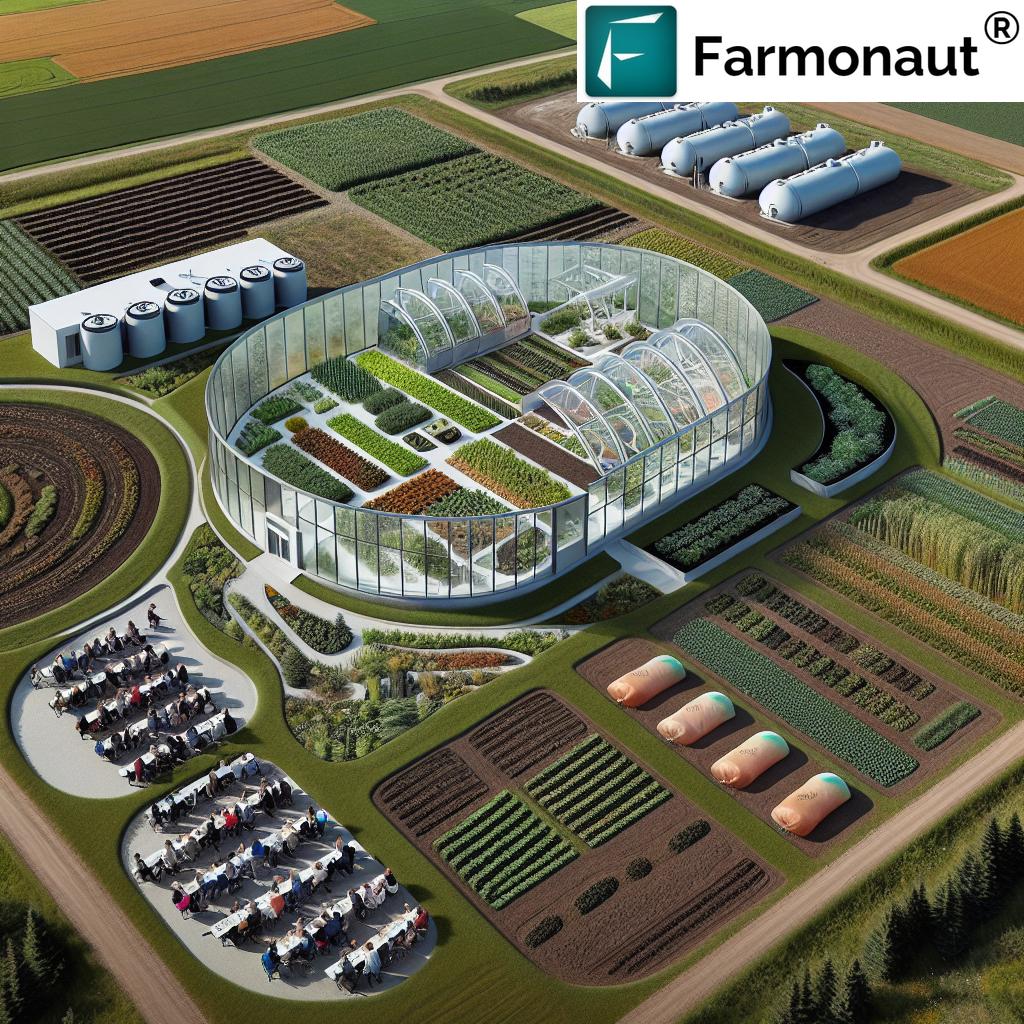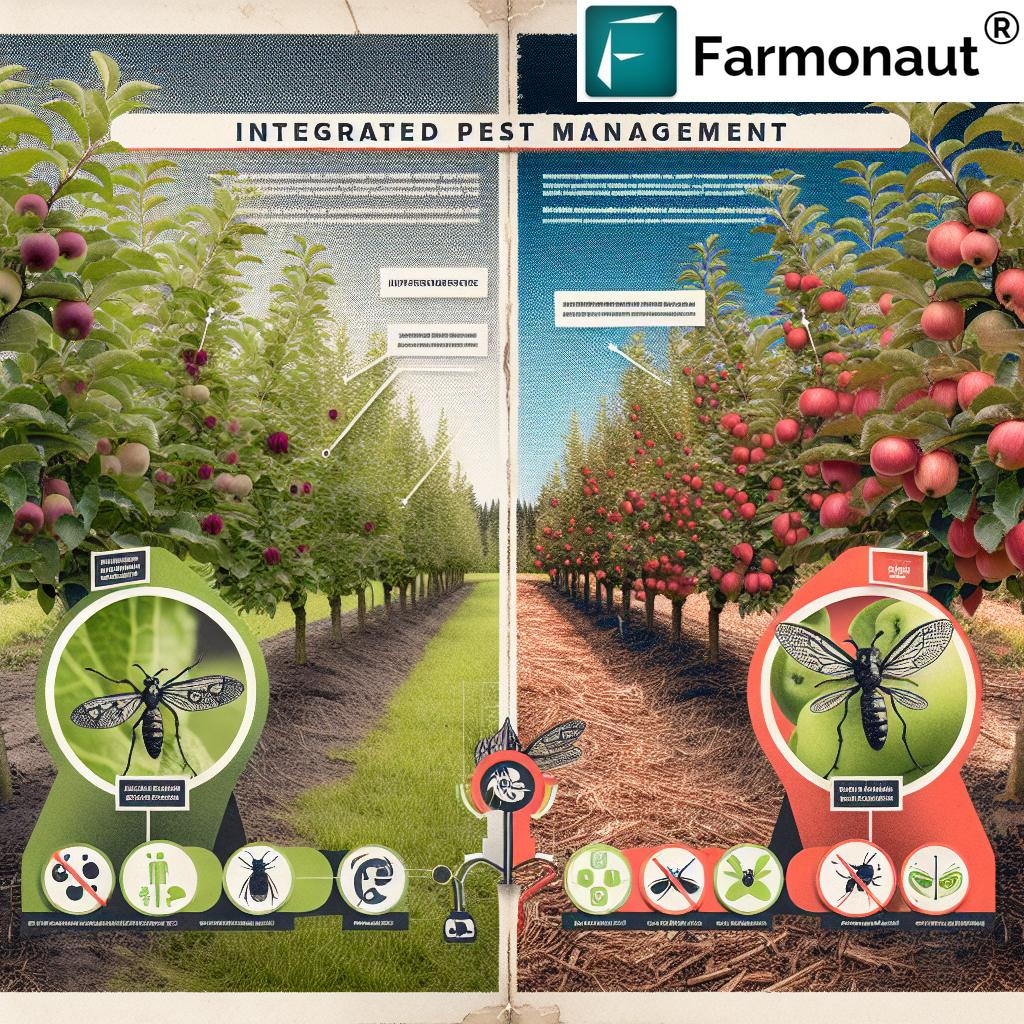Transforming Canadian Agriculture: How Circular Economy Practices Are Revolutionizing Sustainable Farming
“Canadian farms implementing circular economy practices have reduced greenhouse gas emissions by up to 30% in some cases.”
In recent years, we’ve witnessed a remarkable transformation in Canadian agriculture as circular economy practices revolutionize sustainable farming methods. As we delve into this exciting topic, we’ll explore how these innovative approaches are reshaping the agricultural landscape, turning waste into valuable resources, and paving the way for a more sustainable future.
At Farmonaut, we’re committed to advancing sustainable agriculture through cutting-edge technology. Our satellite-based farm management solutions provide farmers with real-time insights to optimize their operations and reduce environmental impact. While we focus on precision agriculture, we’re excited to see how circular economy principles complement our efforts in creating a more resilient and eco-friendly farming sector.

Understanding the Circular Economy in Agriculture
The circular economy in agriculture represents a paradigm shift from the traditional linear “take-make-dispose” model to a more sustainable, closed-loop system. This approach aims to minimize waste, optimize resource use, and regenerate natural systems. In the context of Canadian farming, it’s transforming how we view agricultural byproducts and waste streams, turning them into valuable inputs for other processes.
Key principles of the circular economy in agriculture include:
- Waste reduction and resource efficiency
- Regenerative practices that enhance soil health
- Utilization of renewable energy sources
- Creation of new value streams from agricultural byproducts
By embracing these principles, Canadian farmers are not only addressing environmental concerns but also fostering economic resilience within their communities.
Innovative Waste-to-Energy Systems
One of the most exciting developments in circular agriculture is the implementation of waste-to-energy systems. These technologies are transforming farm waste into valuable energy resources, reducing greenhouse gas emissions, and creating new revenue streams for farmers.
Anaerobic Digestion: Turning Manure into Power
Anaerobic digestion is at the forefront of this revolution. This process breaks down organic matter in the absence of oxygen, producing biogas that can be used to generate electricity or heat. In Ontario, we’ve seen remarkable success stories where farms are capturing methane from livestock waste to produce renewable natural gas (RNG).
Benefits of anaerobic digestion include:
- Reduction of methane emissions from manure storage
- Generation of renewable energy
- Production of nutrient-rich digestate for fertilizer
- Creation of additional income through energy sales and carbon credits
Explore how Farmonaut’s satellite-based crop monitoring can complement your waste-to-energy initiatives. Try our web app today!
Composting: From Waste to Soil Gold
Composting has long been a cornerstone of sustainable agriculture, but its role in the circular economy is more crucial than ever. By recycling organic matter into nutrient-rich soil amendments, Canadian farmers are reducing landfill waste and improving soil health simultaneously.
Community-Supported Composting Initiatives
In British Columbia, we’re seeing innovative community-supported agriculture programs that integrate composting. These initiatives not only enrich local soils but also divert significant amounts of organic waste from municipal systems. The benefits are two-fold: farmers gain access to high-quality compost, and communities reduce their waste management burden.
Key advantages of large-scale composting in agriculture:
- Improved soil structure and water retention
- Enhanced nutrient cycling and soil biodiversity
- Reduced reliance on synthetic fertilizers
- Mitigation of soil erosion and runoff
“Biochar applications in Canadian agriculture can increase crop yields by 10-20% while sequestering carbon for centuries.”
Biochar: The Future of Soil Amendment
Biochar is emerging as a game-changing tool in sustainable agriculture. Produced from agricultural residues through pyrolysis, biochar offers multiple benefits for soil health and carbon sequestration. Farmers in Ontario and Quebec are reporting significant improvements in crop yields and soil resilience after incorporating biochar into their practices.
Advantages of biochar application:
- Long-term carbon sequestration
- Improved soil water retention and nutrient availability
- Enhanced soil microbial activity
- Reduced need for chemical fertilizers
Discover how Farmonaut’s AI-powered advisory system can help you optimize biochar application. Download our Android app now!

Government Support and Industry Collaborations
The transition to circular economy practices in Canadian agriculture is supported by various government programs and industry collaborations. These initiatives are crucial in overcoming barriers to adoption and scaling up sustainable practices across the country.
Agricultural Clean Technology Program
The Canadian government’s Agricultural Clean Technology Program is providing vital funding to help farmers adopt technologies that improve energy efficiency and reduce greenhouse gas emissions. This support is instrumental in helping farms transition to more sustainable operations.
Research and Development Partnerships
Collaborations between farmers, researchers, and private enterprises are driving innovation in circular agriculture. From advanced biochar technologies to cutting-edge waste-to-energy systems, these partnerships are equipping Canadian farmers with the tools they need to embrace sustainable practices.
Leverage Farmonaut’s satellite and weather data API to enhance your agricultural research. Explore our API capabilities.
Environmental and Economic Benefits
The adoption of circular economy practices in Canadian agriculture is yielding significant environmental and economic benefits. Let’s explore some of the key advantages:
Environmental Impact
- Reduction in greenhouse gas emissions
- Improved soil health and biodiversity
- Decreased reliance on synthetic inputs
- Conservation of water resources
Economic Advantages
- New revenue streams from organic fertilizers and renewable energy
- Reduced input costs for farmers
- Access to premium markets for sustainably produced goods
- Increased farm resilience to economic and environmental shocks
Optimize your farm’s economic performance with Farmonaut’s precision agriculture solutions. Get our iOS app today!
Challenges and Opportunities
While the benefits of circular economy practices in agriculture are clear, there are still challenges to widespread adoption. These include:
- High initial costs for implementing new technologies
- Regulatory hurdles and policy gaps
- Lack of awareness and education about available solutions
- Need for infrastructure development to support circular systems
However, these challenges also present opportunities for innovation, collaboration, and policy development. As more success stories emerge and technologies become more accessible, we expect to see accelerated adoption of circular economy practices across Canadian farms.
Comparative Table: Circular Economy Practices in Canadian Agriculture
| Practice | Description | Environmental Benefits | Economic Benefits |
|---|---|---|---|
| Anaerobic Digestion | Converts organic waste into biogas and digestate | Reduces GHG emissions by up to 70%; Improves waste management | Generates renewable energy; Creates new revenue streams (est. $50,000-$200,000/year for medium-sized farms) |
| Composting | Transforms organic waste into nutrient-rich soil amendment | Enhances soil health; Reduces landfill waste by up to 40% | Lowers fertilizer costs; Improves crop yields (5-10% increase) |
| Biochar Application | Uses pyrolyzed agricultural residues as a soil enhancer | Sequesters carbon for centuries; Improves soil water retention | Increases crop yields by 10-20%; Reduces irrigation needs |
| Waste-to-Energy Systems | Converts agricultural waste into various forms of energy | Reduces farm carbon footprint by up to 30% | Provides energy independence; Potential for energy sales (ROI within 5-7 years) |
The Role of Technology in Advancing Circular Agriculture
As we embrace circular economy practices in agriculture, technology plays a crucial role in optimizing these systems and maximizing their benefits. At Farmonaut, we’re at the forefront of this technological revolution, providing farmers with powerful tools to enhance their sustainable farming practices.
Satellite-Based Crop Monitoring
Our satellite-based crop monitoring technology complements circular economy practices by providing real-time insights into crop health, soil moisture, and vegetation indices. This data allows farmers to make precise decisions about resource allocation, reducing waste and optimizing inputs.
AI-Powered Advisory Systems
Farmonaut’s AI-driven advisory system, Jeevn AI, analyzes satellite data and other inputs to provide personalized recommendations for crop management. This technology helps farmers implement circular economy practices more effectively by optimizing resource use and minimizing environmental impact.
Experience the power of AI in agriculture. Try Farmonaut’s web app now!
The Future of Circular Economy in Canadian Agriculture
As we look to the future, the potential for circular economy practices in Canadian agriculture is immense. We anticipate several key developments:
- Increased integration of digital technologies to optimize circular systems
- Development of regional circular economy hubs to facilitate resource sharing
- Expansion of carbon credit markets for agricultural practices
- Greater emphasis on biodiversity and ecosystem services in farming
By embracing these innovations and continuing to invest in sustainable practices, Canadian agriculture can lead the way in creating a more resilient, productive, and environmentally friendly food system.
Conclusion: Embracing a Circular Future
The transformation of Canadian agriculture through circular economy practices represents a pivotal moment in our journey towards sustainability. By turning waste into resources, optimizing energy use, and regenerating natural systems, we’re not only addressing environmental challenges but also creating new opportunities for economic growth and rural development.
As we’ve explored throughout this article, the benefits of adopting circular economy principles in agriculture are far-reaching. From reduced greenhouse gas emissions to improved soil health and new revenue streams, these practices are reshaping the future of farming in Canada.
At Farmonaut, we’re proud to support this transformation by providing cutting-edge technology that complements circular economy practices. Our satellite-based monitoring, AI advisory systems, and data-driven insights empower farmers to make informed decisions that align with sustainable agriculture principles.
As we move forward, collaboration between farmers, researchers, policymakers, and technology providers will be crucial in scaling up these innovative practices. By working together, we can create a more resilient, productive, and sustainable agricultural sector that benefits both people and the planet.
We invite you to join us in this exciting journey towards a circular future in agriculture. Whether you’re a farmer looking to adopt new practices, a researcher exploring innovative solutions, or an enthusiast interested in sustainable agriculture, there’s a role for everyone in this transformative movement.
Ready to take your sustainable farming practices to the next level? Explore Farmonaut’s advanced agricultural solutions:
FAQs about Circular Economy in Canadian Agriculture
- What is a circular economy in agriculture?
A circular economy in agriculture is an approach that aims to minimize waste, optimize resource use, and regenerate natural systems. It involves transforming agricultural byproducts and waste into valuable resources, creating closed-loop systems that benefit both the environment and the economy. - How does anaerobic digestion contribute to sustainable farming?
Anaerobic digestion converts organic waste into biogas and nutrient-rich digestate. This process reduces greenhouse gas emissions, generates renewable energy, and provides an alternative to chemical fertilizers, contributing to more sustainable farming practices. - What are the benefits of using biochar in agriculture?
Biochar improves soil health by enhancing water retention, increasing nutrient availability, and promoting microbial activity. It also sequesters carbon for long periods, making it an effective tool for climate change mitigation in agriculture. - How can Canadian farmers benefit economically from circular economy practices?
Farmers can benefit through new revenue streams from selling renewable energy or organic fertilizers, reduced input costs, access to premium markets for sustainably produced goods, and potential earnings from carbon credits. - What role does technology play in advancing circular agriculture?
Technology, such as Farmonaut’s satellite-based monitoring and AI advisory systems, helps optimize resource use, reduce waste, and improve decision-making in circular agriculture practices. It enables precision farming techniques that align with circular economy principles.
















